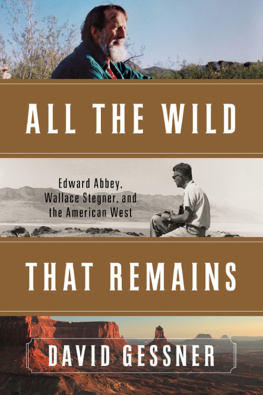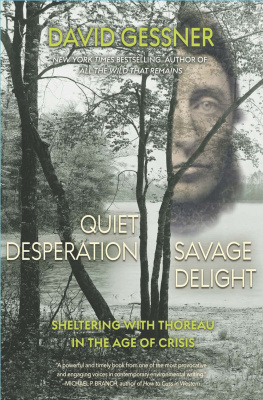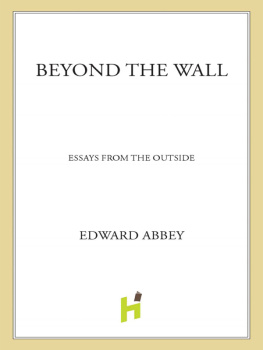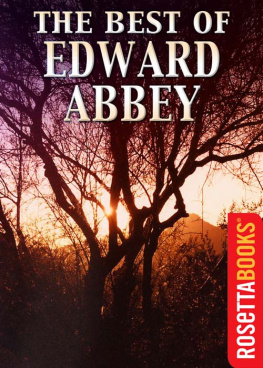
ALL THE WILD THAT REMAINS
EDWARD ABBEY, WALLACE STEGNER,
AND THE AMERICAN WEST
DAVID GESSNER

W. W. NORTON & COMPANY
New York London
London
Copyright 2015 by David Gessner
All rights reserved
First Edition
For information about permission to reproduce selections from this book,
write to Permissions, W. W. Norton & Company, Inc.,
500 Fifth Avenue, New York, NY 10110
For information about special discounts for bulk purchases, please contact
W. W. Norton Special Sales at specialsales@wwnorton.com or 800-233-4830
Book design by Chris Welch
Production manager: Anna Oler
ISBN 978-0-393-08999-8
ISBN 978-0-393-24678-0 (e-book)
W. W. Norton & Company, Inc., 500 Fifth Avenue, New York, NY 10110
www.wwnorton.com
W. W. Norton & Company Ltd., Castle House,
75/76 Wells Street, London W1T 3QT
CONTENTS
The seeds of this book were planted long ago during my years in Colorado, when I first began to study Edward Abbey and Wallace Stegner. Its true that Desert Solitaire was already among my books when I landed in the West, but it would take Rob Bleiberg, Ultimate Frisbee teammate, western convert, and roommate, to open up a larger world to me with the books he brought into our house. Meanwhile, at the University of Colorado, Reg Saner showed me, through words and example, how thinking about the land and the humans and other animals who live on it could be transformed into art. A class with Linda Hogan nudged me toward writing about nature and helped deepen my love of birds, and an academic paper on Abbey for Marty Bickman led to an early essay (and accompanying cartoons) about Abbey and Stegner that would eventually find its way, with the help of Betsy Marston, into High Country News. For companionship and inspiration during those early years in the West I need to thank my classmates and friends Mark Spitzer, Mark Karger, Karen Auvinen, Jim Campbell, and Heidi Krauth. I also need to thank Heidis dad, Lee Krauth, whose underlined and annotated copy of Abbeys Road I borrowed and still have (sorry, Lee). I could also thank almost every one of my Ultimate teammates in Boulder, who were always pushing me toward adventure, particularly Chris Captain Brooks, in whose VW van many of those adventures took place.
Back here in my adopted hometown of Wilmington, North Carolina, where my trip began in the summer of 2012, I had the support of the University of North Carolina Wilmington and my colleagues in the Creative Writing Department. David Webster and Philip Gerard were great early supporters of the project and helped me find the time and funding to make it happen. Bekki Lee, Clyde Edgerton, Mike White, and the rest of the writers who populate our hallway were supportive and inspiring, and Megan Hubbard was, as usual, my go-to person for all things practical. My long trip west was preceded by a few shorter journeys, one of them to Tucson, where I relied on Alison Hawthorne Deming, Simmons Bunting, and Chris Cokinos to help me learn the lay of the land. Also Richard Shelton, who has always been a supporter of my work and who talked to me about his decision to hire Ed Abbey at the University of Arizona. Curator Roger Meyers and the other members of the staff at the University of Arizona Special Collections helped me find my way around Abbeys papers.
In Pennsylvania, I was helped by Ian Marshall and Bob Burkholder, and, thanks to them and to Mark McLaughlin, the director of the Shavers Creek Environmental Center, I was allowed to spend a week in a cabin in the woods. As for Jim Cahalan, author of Edward Abbey: A Life, both the text and my notes must make it clear how indispensable and generous he was during this entire project. If you have enjoyed my book and find yourself still hungry for more Abbey, I enthusiastically recommend that you read his.
Perhaps the most important thank-yous, apart from the final ones, need to go to Page, Lynn, and Allison Stegner, who let me visit their home in Greensboro, Vermont, and freely shared their insights about their famous relative, and who later read an earlier draft of the book. They were the definition of generous. Also thanks to Jen Sahn of Orion magazine, who has always supported me in my work and who accompanied me on a walk to the top of Barr Hill above the Stegners home, the setting of the last scene in Crossing to Safety.
Before I headed west I received the e-mailmy koanfrom Terry Tempest Williams that kicked off the trip. Once I pushed off, my first stop was in Port Royal, Kentucky, at the home of Wendell and Tanya Berry, who graciously made time to talk to me, with Wendell later reading some of the early pages. Thanks also to Erik Reece in Lexington for giving me a couch to sleep on and for introducing me to the inimitable Ed McClanahan, who shared his thoughts on Abbey and Stegner.
My next stop was in St. Louis, where I stayed at the home of Tom Beattie, who took me down to the Missouri River, bought me drinks, and set me up with contacts for the rest of my trip out west. In Denver, I stayed with Randy Ricks, who has always been a great friend and a big supporter of my work, and in Paonia I spent two nights in the cabin of Adam Petry, writer, scientist, former student, present friend. During my time in that delightful mountain town, I also attended a party at the home of the brilliant environmental writer Michelle Nijhuis, and it was there that Cally Carswell, a contributing editor at High Country News, pointed me toward Vernal, Utah.
In Moab, Andy Nettell of Back of Beyond Books took time out to speak to me about his encounters with Abbey, and Ken Sleight invited me up to his bunker of an office, where we picked up a conversation from four years before. That earlier trip to Kens Pack Creek was made possible by Susan Zakin and made more fun by Dave Smith, who let me try to keep up with him on the Slickrock trail. During that trip, Jane Sleight was a generous hostess, cooking us dinner and refereeing as Ken, Susan, and I yelled at the TV during the first Sarah PalinJoe Biden debate. During my more recent trip to Pack Creek, Bob and Cady Aspinwall were kind enough to show me the small cabin where Abbey wrote.
My thinking about the economies of western towns owes much to Thomas Michael Power, a professor in the economics department at the University of Montana, and to Ben Alexander of Headwaters Economics, who was always ready to answer my questions. I also need to thank Dave Earley, Liz Thomas of the Southern Utah Wilderness Alliance, and Bill Hedden, executive director of the Grand Canyon Trust, all of whom I interviewed on my earlier trip.
In Vernal, Utah, I relied on the guidance of legendary river runner and provocateur Herm Hoops. Bruce and Jane Gordon of EcoFlight, a nonprofit organization that sponsors flights all over the western landscape, helped me see with my own eyes what all that drilling was doing to the land, and during our flight, Ray Bloxham and Steve Bloch of the Southern Utah Wilderness Alliance provided commentary as I took notes. In addition, Bloxham and Bloch were extremely helpful in the months after our flight, and I owe them many thanks for allowing me to pester them with e-mails. The filmmaker John McChesney also added insightful comments during the flight.
I need to pause here and thank the writer and editor George Black for putting me in touch with the Gordons and EcoFlight, and for six years ago first nudging me toward and then guiding me into what was then the unfamiliar world of environmental journalism. If not for George and the magazine he edited,
Next page








 London
London